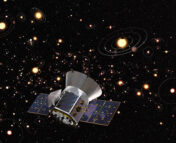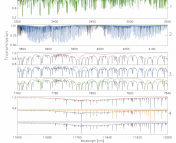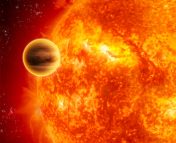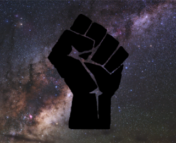This Bite is part of Astrobites’ ongoing efforts to celebrate all cultures and identities in astronomy—specifically, we’re highlighting LGBTQIA+ astronomers during June as part of Pride Month!
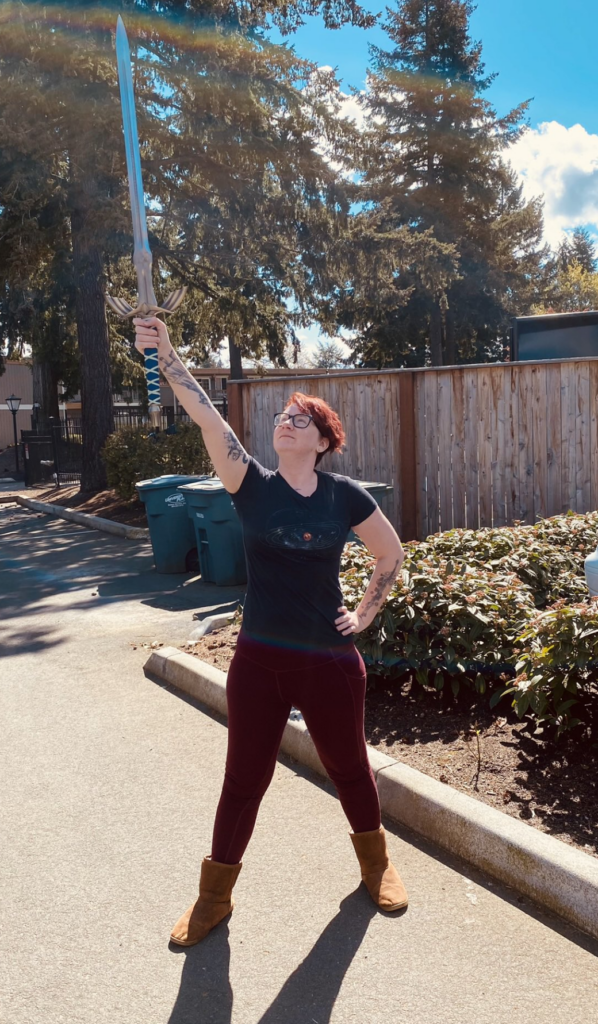
Dr. Kaitlin Rasmussen is interested in pushing boundaries — everything from the boundaries of gender, to the boundaries of what we can do with spectroscopy. They are a non-binary bisexual astronomy postdoc in the University of Washington’s Virtual Planetary Lab, currently investigating what will be possible with transmission spectroscopy in the era of JWST.
They’ve done a lot of cool science, all broadly connected around the theme of spectra. (There’s a reason their username is @TooManySpectra on Twitter!) But their path started somewhere entirely different, since Rasmussen entered college as a music education major. They realized, though, that a job in music education would be a hard path, given how undervalued and underpaid those teachers are. “Long story short,” Rasmussen says, “I chose astrophysics instead.”
After working hard to catch up on their math and physics courses, they graduated from Florida State in 2015 with an undergrad degree in Physics and Astrophysics. Their work in undergrad focused on active galactic nuclei, which turned out to be something they were decidedly not interested in. “One thing that I had always thought was really exciting was exoplanets, because I used to watch like the Discovery Channel specials with Sara Seager,” they say. “They would talk about how transmission spectroscopy is gonna change the future, and you’re gonna be able to see the atmosphere of the planet. And I’m so so excited by that. So that’s what I decided that I wanted to do with my career.”
Rasmussen went on to grad school — but, surprisingly, not to work on exoplanets. They were accepted into one school (Notre Dame), and the exoplanet faculty there was not taking students that year. So, instead, they ended up working on extremely precise spectroscopic measurements of the abundances of uranium, thorium, and other heavy elements in really old stars to learn about things like neutron star mergers and core-collapse supernovae in the early universe.
They still wanted to be in the world of exoplanets, though, so they took a leap of faith and applied to postdocs in exoplanet science. Rasmussen ended up at the University of Michigan to work with Professor Emily Rauscher and collaborators on the WINERED spectrograph to characterize Hot Jupiters with transmission spectroscopy. Since COVID delayed the instrument’s delivery to the Magellan Telescope, they instead turned to existing data, trying to get as much information out of it as possible, and to simulations, predicting what could be done when WINERED finally makes it on sky. Rasmussen describes how their precision spectroscopy experience was useful for all these different projects, exoplanet related or not.

Now, at the University of Washington, Rasmussen is taking that expertise and applying it to small planets, pushing the boundaries of what we can do. “One thing that I’ve done recently is that I obtained some really, really, really good spectra of 55 Cancri e, which is a lava planet,” they say. “So it’s just a spicy little meatball on like a 17 hour orbit. It’s basically like Io, the moon, if it was a whole planet roughly Earth’s mass.” Astronomers are curious about this planet’s atmosphere, and whether it’s full of minerals from constantly erupting volcanoes or not. Rasmussen’s preliminary work with spectra from MAROON-X shows that it’s actually just a bare rock, floating around in space without the fantastical iron atmosphere others proposed.

Science isn’t their only talent, though — Rasmussen is also a science fiction writer, and even has a book deal for an upcoming non-fiction popular science book. “I love writing queer, anti-capitalist science fiction,” they say. “In all of my stories, the protagonist is bisexual or non-binary.” Their book, titled Life in Seven Numbers: The Drake Equation Revealed, is a walk-through of all the terms in the famous Drake Equation and their context in astrobiology. It’s slated to be published mid-2024 by Princeton University Press.
Rasmussen has also been an outspoken advocate for queer people in astronomy, particularly non-binary astronomers such as themself. Recently, they wrote a white paper on gender and being non-binary in astronomy for the Astro2020 Decadal Survey — if you’re interested, we’ve even got an Astrobite about it! Although Rasmussen is proud to be queer, their identity hasn’t always been accepted. They recalled witnessing rampant homophobia in graduate school, such as a bisexual male colleague being treated poorly for “dressing nicely.” The school would even reportedly limit student groups’ abilities to bring queer and trans speakers to events and host events and debates around topics that questioned the humanity of queer people, such as “should gay people be allowed to adopt?” As a result, they didn’t feel safe to be visibly and publicly out during grad school, as did many of their peers.
“When you’re one of a few or if you’re the only queer person in your department. It’s just hard. You’re not on the same wavelength as your cis het, you know, largely male colleagues,” they say.
Thankfully, they have found more accepting communities, such as those at University of Michigan and University of Washington. “I felt like I had kind of an advantage because there’s this cool queer community I can hang out with,” they say. “We would have meetups and potlucks and chat about scientific connections.”
For Rasmussen, this is what being queer is all about: community. They explain, “It’s really this network of people who are really on the same wavelength and I can connect with personally. They understand my memes. And they understand my, my sense of humor, and you know, they understand when I’m like, ‘Oh, are straight people okay?’”
For other non-binary astronomers out there, Rasmussen says there’s a big non-binary Slack workspace that you can join to find community, as well as other groups and resources run by the International Society of Non-Binary Scientists. 500 Queer Scientists also maintains an out list that you can use to find colleagues who share your identities, and there is another astronomy-specific out list. Wherever you are, find that community — the people who you relate to, and a broad network of people who will support you, especially through graduate school.

Astrobite edited by: Sahil Hegde, Macy Huston
Featured image credit: Wikimedia Commons

